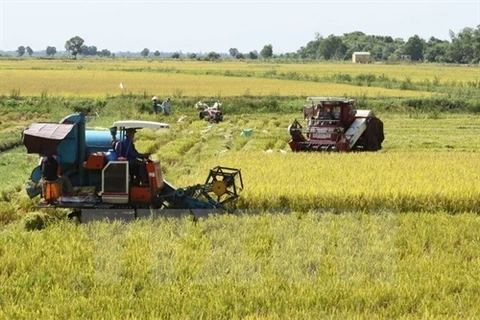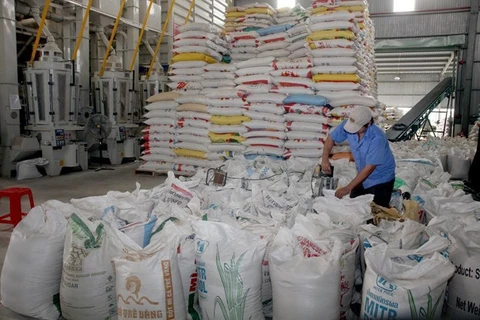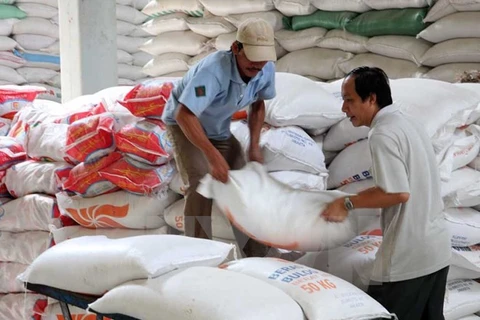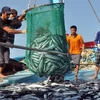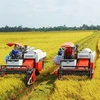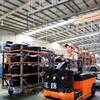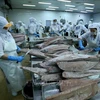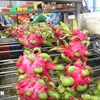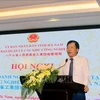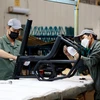HCM City (VNA/VNS) - An Giang Import Export Company (Angimex), one of the large rice export companies in Vietnam, plans to focus on improving its rice quality and better controlling plant-protection residues to promote rice exports, especially to the US and EU markets.
Vo Truong Giang, director of Angimex’s raw material development centre, said that Angimex exported about 120,000 tonnes of rice last year to many markets, including Asia, Australia, Japan and the US.
Exports fell by 20 percent over 2015 due to drastic competition with Thai rice and an increase in rice production in Vietnam’s traditional rice-importing countries, he said.
“It will be hard to compete with Thailand in exporting white rice. Therefore, our orientation for this year is to focus on controlling residues and expand production of specialty fragrant rice to boost export to the US and EU.”
“The US has a huge demand for fragrant rice. But to export to the market, our rice must meet hygiene and food safety standards.”
The company has decided to rent 100ha of land to cultivate rice for export to the US, he said.
Giang said the company has more than 3,000ha of rice material zones in which it has developed close linkages with farmers and cooperatives in An Giang, Kien Giang and Dong Thap to grow Japonica (a Japanese rice variety) and Jasmine fragrant rice, he said.
“Asian countries, especially China, have high demand for Japonica rice,” he said.
With a forecast that rice export would continue to face difficulties this year, not only Angimex but also other rice exporters and producers have mapped out measures to boost consumption of their products this year.
Duong Van Hung, director of Tan Cuong Agricultural Services Cooperative in Dong Thap province, which has more than 1,200ha under rice cultivation, mainly fragrant rice, said the co-operative would focus on improving quality to ensure that its rice meets hygiene and food safety standards set by importing countries.
“Currently, we have 200ha for growing organic rice and 100ha for safe rice,” he said. “We collaborated with a rice export company to market our organic rice in the US market and to be accepted by the market.”
Rice productivity following organic cultivation is in general 20-30 percent lower than traditionally planted rice, but selling prices are 30-40 percent higher than traditionally planted rice, he said.
“We will expand the area to cultivate safe rice in the coming time. I think if our products meet hygiene and food safety standards, there will be nothing to worry about in terms of consumption,” he said.
According to the Ministry of Agriculture and Rural Development, Vietnam exported an estimated 4.88 million tonnes of rice last year, earning 2.2 billion USD, a year-on-year decrease of 25.8 percent in volume and 21.2 percent in value.
Deputy Minister Tran Thanh Nam said free trade agreements would open opportunities for Vietnam to enter markets like the US, the EU and Japan, but it would bring challenges due to lack of competitiveness, especially in terms of quality and branding positioning, compared to competitors.
Nam said that rice exports last year did not meet expectations, especially because of market difficulties.
“But I think it was a lesson for enterprises. Previously, we mainly focused on quantity. This should be changed now. Enterprises must establish their own material zones and focus on improving quality of their rice to international standards,” he said.
Pham Thai Binh, director of Can Tho-based Trung An Hi-Tech Farming JSC, a large rice exporter, said consumers both at home and abroad are becoming more and more aware of what they eat and are willing to pay more for safe products.
To improve the competitiveness of Vietnamese rice, farmers and businesses must join hands to create large-scale rice fields, apply modern farming techniques and mechanise production, he said.
“Businesses must play a main role in the connection chain, providing farmers with input materials and strictly supervise the production process of farmers as well as ensure outlets for their products,” he said.
The company has established a close link with farmers to grow fragrant Jasmine rice, Japonica and other rice following GlobalGap and organic standards, he said.
Its rice products are available in many countries, including the US, the EU and Southeast Asia, with exports accounting for 65 percent of its total production output, he said.
According to experts, the variety of rice is an important factor to improve rice quality.
Huynh The Nang, chairman of the Vietnam Food Association, said there are hundreds of rice varieties but many have similar quality.
Researches to create new high-quality rice varieties that are fragrant, soft and different from other varieties should be encouraged, he said, adding that this would improve Vietnam’s rice quality and competitiveness.
Le Van Banh, head of the ministry’s Department of Processing and Trade for Agro-Forestry-Fisheries Products and Salt Production, said that developing brands for rice products was important to help raise the competitiveness of Vietnamese rice at home and abroad.-VNA
Vo Truong Giang, director of Angimex’s raw material development centre, said that Angimex exported about 120,000 tonnes of rice last year to many markets, including Asia, Australia, Japan and the US.
Exports fell by 20 percent over 2015 due to drastic competition with Thai rice and an increase in rice production in Vietnam’s traditional rice-importing countries, he said.
“It will be hard to compete with Thailand in exporting white rice. Therefore, our orientation for this year is to focus on controlling residues and expand production of specialty fragrant rice to boost export to the US and EU.”
“The US has a huge demand for fragrant rice. But to export to the market, our rice must meet hygiene and food safety standards.”
The company has decided to rent 100ha of land to cultivate rice for export to the US, he said.
Giang said the company has more than 3,000ha of rice material zones in which it has developed close linkages with farmers and cooperatives in An Giang, Kien Giang and Dong Thap to grow Japonica (a Japanese rice variety) and Jasmine fragrant rice, he said.
“Asian countries, especially China, have high demand for Japonica rice,” he said.
With a forecast that rice export would continue to face difficulties this year, not only Angimex but also other rice exporters and producers have mapped out measures to boost consumption of their products this year.
Duong Van Hung, director of Tan Cuong Agricultural Services Cooperative in Dong Thap province, which has more than 1,200ha under rice cultivation, mainly fragrant rice, said the co-operative would focus on improving quality to ensure that its rice meets hygiene and food safety standards set by importing countries.
“Currently, we have 200ha for growing organic rice and 100ha for safe rice,” he said. “We collaborated with a rice export company to market our organic rice in the US market and to be accepted by the market.”
Rice productivity following organic cultivation is in general 20-30 percent lower than traditionally planted rice, but selling prices are 30-40 percent higher than traditionally planted rice, he said.
“We will expand the area to cultivate safe rice in the coming time. I think if our products meet hygiene and food safety standards, there will be nothing to worry about in terms of consumption,” he said.
According to the Ministry of Agriculture and Rural Development, Vietnam exported an estimated 4.88 million tonnes of rice last year, earning 2.2 billion USD, a year-on-year decrease of 25.8 percent in volume and 21.2 percent in value.
Deputy Minister Tran Thanh Nam said free trade agreements would open opportunities for Vietnam to enter markets like the US, the EU and Japan, but it would bring challenges due to lack of competitiveness, especially in terms of quality and branding positioning, compared to competitors.
Nam said that rice exports last year did not meet expectations, especially because of market difficulties.
“But I think it was a lesson for enterprises. Previously, we mainly focused on quantity. This should be changed now. Enterprises must establish their own material zones and focus on improving quality of their rice to international standards,” he said.
Pham Thai Binh, director of Can Tho-based Trung An Hi-Tech Farming JSC, a large rice exporter, said consumers both at home and abroad are becoming more and more aware of what they eat and are willing to pay more for safe products.
To improve the competitiveness of Vietnamese rice, farmers and businesses must join hands to create large-scale rice fields, apply modern farming techniques and mechanise production, he said.
“Businesses must play a main role in the connection chain, providing farmers with input materials and strictly supervise the production process of farmers as well as ensure outlets for their products,” he said.
The company has established a close link with farmers to grow fragrant Jasmine rice, Japonica and other rice following GlobalGap and organic standards, he said.
Its rice products are available in many countries, including the US, the EU and Southeast Asia, with exports accounting for 65 percent of its total production output, he said.
According to experts, the variety of rice is an important factor to improve rice quality.
Huynh The Nang, chairman of the Vietnam Food Association, said there are hundreds of rice varieties but many have similar quality.
Researches to create new high-quality rice varieties that are fragrant, soft and different from other varieties should be encouraged, he said, adding that this would improve Vietnam’s rice quality and competitiveness.
Le Van Banh, head of the ministry’s Department of Processing and Trade for Agro-Forestry-Fisheries Products and Salt Production, said that developing brands for rice products was important to help raise the competitiveness of Vietnamese rice at home and abroad.-VNA
VN


